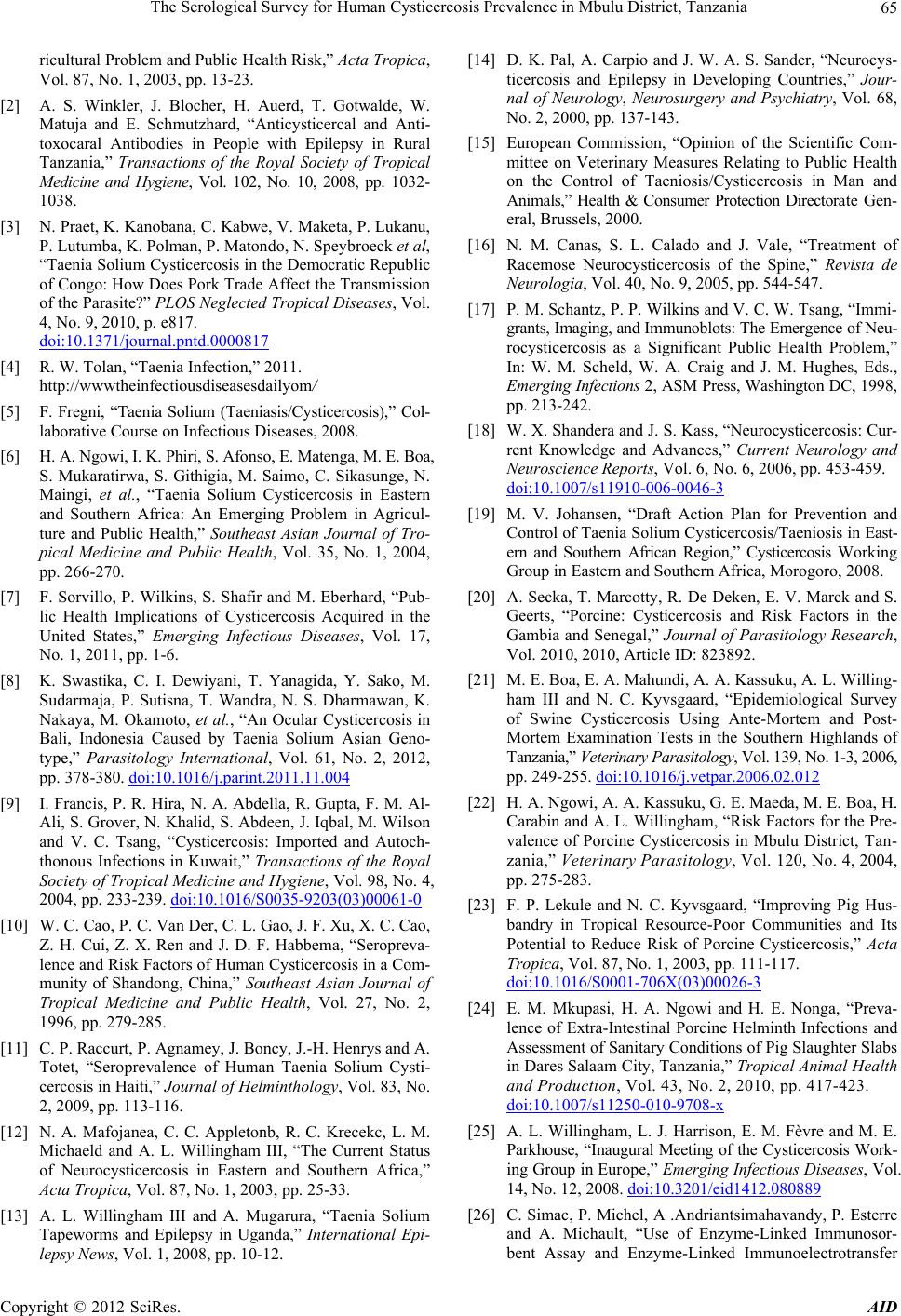
The Serological Survey for Human Cysticercosis Prevalence in Mbulu District, Tanzania 65
ricultural Problem and Public Health Risk,” Acta Tropica,
Vol. 87, No. 1, 2003, pp. 13-23.
[2] A. S. Winkler, J. Blocher, H. Auerd, T. Gotwalde, W.
Matuja and E. Schmutzhard, “Anticysticercal and Anti-
toxocaral Antibodies in People with Epilepsy in Rural
Tanzania,” Transactions of the Royal Society of Tropical
Medicine and Hygiene, Vol. 102, No. 10, 2008, pp. 1032-
1038.
[3] N. Praet, K. Kanobana, C. Kabwe, V. Maketa, P. Lukanu,
P. Lutumba, K. Polman, P. Matondo, N. Speybroeck et al,
“Taenia Solium Cysticercosis in the Democratic Republic
of Congo: How Does Pork Trade Affect the Transmission
of the Parasite?” PLOS Neglected Tropical Diseases, Vol.
4, No. 9, 2010, p. e817.
doi:10.1371/journal.pntd.0000817
[4] R. W. Tolan, “Taenia Infection,” 2011.
http://wwwtheinfectiousdiseasesdailyom/
[5] F. Fregni, “Taenia Solium (Taeniasis/Cysticercosis),” Col-
laborative Course on Infectious Diseases, 2008.
[6] H. A. Ngowi, I. K . Phir i, S. A fonso, E. Matenga, M. E. Boa,
S. Mukaratirwa, S. Githigia, M. Saimo, C. Sikasunge, N.
Maingi, et al., “Taenia Solium Cysticercosis in Eastern
and Southern Africa: An Emerging Problem in Agricul-
ture and Public Health,” Southeast Asian Journal of Tro-
pical Medicine and Public Health, Vol. 35, No. 1, 2004,
pp. 266-270.
[7] F. Sorvillo, P. Wilkins, S. Shafir and M. Eberhard, “Pub-
lic Health Implications of Cysticercosis Acquired in the
United States,” Emerging Infectious Diseases, Vol. 17,
No. 1, 2011, pp. 1-6.
[8] K. Swastika, C. I. Dewiyani, T. Yanagida, Y. Sako, M.
Sudarmaja, P. Sutisna, T. Wandra, N. S. Dharmawan, K.
Nakaya, M. Okamoto, et al ., “An Ocular Cysticercosis in
Bali, Indonesia Caused by Taenia Solium Asian Geno-
type,” Parasitology International, Vol. 61, No. 2, 2012,
pp. 378-380. doi:10.1016/j.parint.2011.11.004
[9] I. Francis, P. R. Hira, N. A. Abdella, R. Gupta, F. M. Al-
Ali, S. Grover, N. Khalid, S. Abdeen, J. Iqbal, M. Wilson
and V. C. Tsang, “Cysticercosis: Imported and Autoch-
thonous Infections in Kuwait,” Transactions of the Royal
Society of Tropical Medicine and Hygiene, Vol. 98, No. 4,
2004, pp. 233-239. doi:10.1016/S0035-9203(03)00061-0
[10] W. C. Cao, P. C. Van Der, C. L. Gao, J. F. Xu, X. C. Cao,
Z. H. Cui, Z. X. Ren and J. D. F. Habbema, “Seropreva-
lence and Risk Factors of Human Cysticercosis in a Com-
munity of Shandong, China,” Southeast Asian Journal of
Tropical Medicine and Public Health, Vol. 27, No. 2,
1996, pp. 279-285.
[11] C. P. Raccurt, P. Agnamey, J. Boncy, J.-H. Henrys and A.
Totet, “Seroprevalence of Human Taenia Solium Cysti-
cercosis in Haiti,” Journal of Helminthology, Vol. 83, No.
2, 2009, pp. 113-116.
[12] N. A. Mafojanea, C. C. Appletonb, R. C. Krecekc, L. M.
Michaeld and A. L. Willingham III, “The Current Status
of Neurocysticercosis in Eastern and Southern Africa,”
Acta Tropica, Vol. 87, No. 1, 2003, pp. 25-33.
[13] A. L. Willingham III and A. Mugarura, “Taenia Solium
Tapeworms and Epilepsy in Uganda,” International Epi-
lepsy News, Vol. 1, 2008, pp. 10-12.
[14] D. K. Pal, A. Carpio and J. W. A. S. Sander, “Neurocys-
ticercosis and Epilepsy in Developing Countries,” Jour-
nal of Neurology, Neurosurgery and Psychiatry, Vol. 68,
No. 2, 2000, pp. 137-143.
[15] European Commission, “Opinion of the Scientific Com-
mittee on Veterinary Measures Relating to Public Health
on the Control of Taeniosis/Cysticercosis in Man and
Animals,” Health & Consumer Protection Directorate Gen-
eral, Brussels, 2000.
[16] N. M. Canas, S. L. Calado and J. Vale, “Treatment of
Racemose Neurocysticercosis of the Spine,” Revista de
Neurologia, Vol. 40, No. 9, 2005, pp. 544-547.
[17] P. M. Schantz, P. P. Wilkins and V. C. W. Tsang, “Immi-
grants, Imaging, and Immunobl ots: The Emerge nce of Neu -
rocysticercosis as a Significant Public Health Problem,”
In: W. M. Scheld, W. A. Craig and J. M. Hughes, Eds.,
Emerging Infections 2, ASM Press, Washingto n DC, 1998,
pp. 213-242.
[18] W. X. Shandera and J. S. Kass, “Neurocy sticercosis: Cur-
rent Knowledge and Advances,” Current Neurology and
Neuroscience Repo r t s, Vol. 6, No. 6, 2006, pp. 453-459.
doi:10.1007/s11910-006-0046-3
[19] M. V. Johansen, “Draft Action Plan for Prevention and
Control of Taenia Solium Cysticercosis/Taeniosis in East-
ern and Southern African Region,” Cysticercosis Working
Group in Eastern and Southern Africa, Morogoro, 2008.
[20] A. Secka, T. Marcotty, R. De Deken, E. V. Marck and S.
Geerts, “Porcine: Cysticercosis and Risk Factors in the
Gambia and Senegal,” Journal of Parasitology Research,
Vol. 2010, 2010, Article ID: 823892.
[21] M. E. Boa, E. A. Mahundi, A. A. Kassuku, A. L. Willing-
ham III and N. C. Kyvsgaard, “Epidemiological Survey
of Swine Cysticercosis Using Ante-Mortem and Post-
Mortem Examination Tests in the Southern Highlands of
Tanzani a,” Veterinary Parasitology, Vol. 139, No. 1-3, 2006,
pp. 249-255. doi:10.1016/j.vetpar.2006.02.012
[22] H. A. Ngowi, A. A. Kassuku, G. E. Maeda, M. E. Boa, H.
Carabin and A. L. Willingham, “Risk Factors for the Pre-
valence of Porcine Cysticercosis in Mbulu District, Tan-
zania,” Veterinary Parasit ology, V ol . 1 2 0 , N o . 4 , 2004,
pp. 275-283.
[23] F. P. Lekule and N. C. Kyvsgaard, “Improving Pig Hus-
bandry in Tropical Resource-Poor Communities and Its
Potential to Reduce Risk of Porcine Cysticercosis,” Acta
Tropica, Vol. 87, No. 1, 2003, pp. 111-117.
doi:10.1016/S0001-706X(03)00026-3
[24] E. M. Mkupasi, H. A. Ngowi and H. E. Nonga, “Preva-
lence of Extra-Intestinal Porcine Helminth Infections and
Assessment of Sanitary Conditions of Pig Slaughter Slabs
in Dares Salaam City, Tanzania,” Tropical Animal Health
and Production, Vol. 43, No. 2, 2010, pp. 417-423.
doi:10.1007/s11250-010-9708-x
[25] A. L. Willingham, L. J. Harrison, E. M. Fèvre and M. E.
Parkhouse, “Inaugural Meeting of the Cysticercosis Work-
ing Group in Europe,” Emerging Infectious Diseases, Vol.
14, No. 12, 2008. doi:10.3201/eid1412.080889
[26] C. Simac, P. Michel, A .Andriantsimahavandy, P. Esterre
and A. Michault, “Use of Enzyme-Linked Immunosor-
bent Assay and Enzyme-Linked Immunoelectrotransfer
Copyright © 2012 SciRes. AID